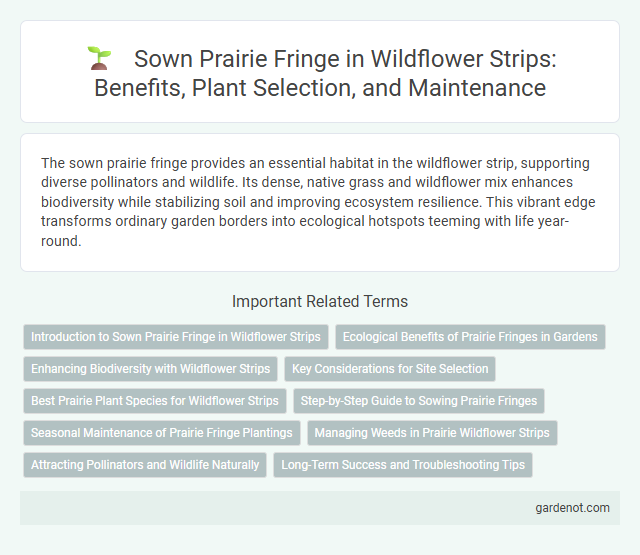The sown prairie fringe provides an essential habitat in the wildflower strip, supporting diverse pollinators and wildlife. Its dense, native grass and wildflower mix enhances biodiversity while stabilizing soil and improving ecosystem resilience. This vibrant edge transforms ordinary garden borders into ecological hotspots teeming with life year-round.
Introduction to Sown Prairie Fringe in Wildflower Strips
Sown prairie fringe in wildflower strips replicates the natural transition zone between prairie grasslands and adjacent ecosystems, enhancing biodiversity and habitat connectivity. This tailored seed mix includes native grass species like little bluestem and Indian grass alongside diverse wildflowers such as purple coneflower and black-eyed Susan, promoting pollinator activity and soil health. Integrating sown prairie fringe into wildflower strips supports ecological resilience by providing shelter and foraging resources for insects, birds, and small mammals across different seasons.
Ecological Benefits of Prairie Fringes in Gardens
Sown prairie fringes in gardens enhance biodiversity by providing essential habitats for pollinators such as bees, butterflies, and native birds. These strips improve soil health through deep-rooted prairie grasses that reduce erosion and increase nutrient cycling. Incorporating prairie fringes supports local ecosystems by promoting native plant species resilience and natural pest control.
Enhancing Biodiversity with Wildflower Strips
Sown prairie fringe wildflower strips significantly enhance biodiversity by providing essential habitats for pollinators, birds, and beneficial insects. These strips increase plant species richness and improve ecosystem resilience by supporting native flora and fauna. Integrating sown prairie fringes into agricultural landscapes fosters natural pest control and promotes soil health through increased organic matter and microbial activity.
Key Considerations for Site Selection
Selecting a site for establishing a sown prairie fringe requires evaluating soil type, drainage, and sunlight exposure to ensure optimal growth conditions for native wildflowers and grasses. Prioritizing areas with well-drained, loamy soils and full to partial sun enhances plant diversity and resilience against invasive species. Proximity to existing natural habitats supports pollinator activity and accelerates ecological integration of the wildflower strip.
Best Prairie Plant Species for Wildflower Strips
Sown prairie fringes thrive with prairie plant species like little bluestem (Schizachyrium scoparium), purple coneflower (Echinacea purpurea), and black-eyed Susan (Rudbeckia hirta) that provide vibrant color and support pollinators. These species are drought-tolerant, enhance soil health, and create habitat for beneficial insects, making them ideal for wildflower strips. Incorporating diverse prairie grasses and native forbs ensures long-lasting blooms and ecological balance in sown prairie strips.
Step-by-Step Guide to Sowing Prairie Fringes
Sowing a prairie fringe begins with selecting a well-drained soil area that receives full sun exposure to ensure optimal growth of native wildflowers. Prepare the soil by removing existing vegetation and loosening the surface to create a suitable seedbed for prairie species such as Echinacea, Black-eyed Susan, and Butterfly Weed. After evenly distributing the seeds, lightly rake the area to cover them with soil, water consistently to maintain moisture, and monitor for germination during the 2-4 week period following sowing.
Seasonal Maintenance of Prairie Fringe Plantings
Seasonal maintenance of sown prairie fringe plantings involves timely mowing and selective removal of invasive species to promote native wildflower growth and biodiversity. Regular prescribed burns or controlled mowing in late winter or early spring help rejuvenate prairie fringe habitats, enhancing soil health and preventing woody plant encroachment. Monitoring and adaptive management ensure optimal flowering periods and support pollinator populations throughout the growing season.
Managing Weeds in Prairie Wildflower Strips
Effective weed management in sown prairie fringe wildflower strips involves regular monitoring and targeted removal to promote native species growth. Utilizing selective herbicides and mechanical control methods such as mowing or hand-pulling helps reduce invasive weed populations without damaging desirable prairie plants. Maintaining soil health and ensuring proper seed mix diversity further suppresses weed establishment and supports long-term ecosystem balance.
Attracting Pollinators and Wildlife Naturally
Sown prairie fringe plants create vital habitats that attract a diverse range of pollinators such as bees, butterflies, and hummingbirds by providing abundant nectar and pollen sources throughout the growing season. These native wildflowers and grasses support local ecosystems by sustaining wildlife species, including beneficial insects and small mammals, while enhancing biodiversity in urban and rural landscapes. Integrating sown prairie fringes into environmental restoration projects promotes natural pollination processes and contributes to the resilience and health of surrounding habitats.
Long-Term Success and Troubleshooting Tips
Sown prairie fringe enhances biodiversity and soil health by establishing a resilient habitat of native wildflowers and grasses. Long-term success depends on proper site preparation, selecting regionally adapted seed mixes, and consistent management practices such as periodic mowing and controlled burns to prevent invasive species. Troubleshooting common issues involves monitoring for poor seedling establishment, adjusting watering schedules, and addressing pest infestations with environmentally friendly methods.
Sown prairie fringe Infographic

 gardenot.com
gardenot.com